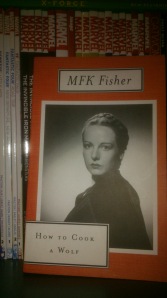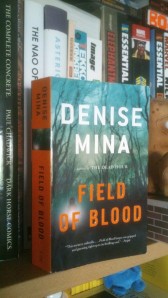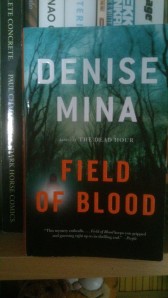Irving, John (2012), In One Person, Simon & Schuster
ISBN 9781451664126
 So in my recent run of reviews I reviewed and discussed some writers I enjoy greatly. Among them perennial favorites. I however like to think that I am good at being reasonably, well, reasonable and reasoned about these matters. With a handful of writers, I just completely lose that ability. One of those writers is John Irving. I cannot, with any degree of certainty, tell you whether he’s a genuinely good writer. I know I love his work. I am excited for his books to come out, I enjoy his writing and characters and plots greatly, I’m just fundamentally a fan of his work. When I mentioned, in my review of Lawrence Norfolk’s last novel, that it was like comfort food when it came out after such a long period of silence, well, that’s how Irving’s work is for me all of the time. That is not to say that I don’t see faults in his work. It’s just that they don’t necessarily influence what I think of the books. A Son of the Circus, a highly problematic book, is also one of my favorites. I make exceptions for exactly 3 of his novels. I think his first two novels are markedly subpar, apprentice efforts, but many writers have those. And then there’s The Fourth Hand (2001), which I read the minute it came out and which turned out to be a sloppy, rushed self-caricature of a novel that I always somehow blamed on his preoccupation with what he called his “movie business”. Irving has since nicely recovered from it, publishing good to very good novels. His most recent one, In One Person may just be his best novel in many years, one of his very best efforts. As far as I can tell. A writer whose work I am so personally influenced by and indebted to is hard to recommend to others, but I can say this much: if you have read any other Irving book and enjoyed it, you will like this one, as well. In many ways it serves as a summary of a long and great career, touching on issues, tropes and ideas prevalent in many of his best books. That said, there’s a second group of readers to whom I can issue a definite recommendation: if you read any Irving and fundamentally disliked it, this is also not for you. It is not a book that will win over critics of his work. For everyone else, I recommend reading the rest of my review, maybe. In my opinion, In One Person, an interrogation of how the life that we led outlasts us, is a fantastic book, maybe even great.
So in my recent run of reviews I reviewed and discussed some writers I enjoy greatly. Among them perennial favorites. I however like to think that I am good at being reasonably, well, reasonable and reasoned about these matters. With a handful of writers, I just completely lose that ability. One of those writers is John Irving. I cannot, with any degree of certainty, tell you whether he’s a genuinely good writer. I know I love his work. I am excited for his books to come out, I enjoy his writing and characters and plots greatly, I’m just fundamentally a fan of his work. When I mentioned, in my review of Lawrence Norfolk’s last novel, that it was like comfort food when it came out after such a long period of silence, well, that’s how Irving’s work is for me all of the time. That is not to say that I don’t see faults in his work. It’s just that they don’t necessarily influence what I think of the books. A Son of the Circus, a highly problematic book, is also one of my favorites. I make exceptions for exactly 3 of his novels. I think his first two novels are markedly subpar, apprentice efforts, but many writers have those. And then there’s The Fourth Hand (2001), which I read the minute it came out and which turned out to be a sloppy, rushed self-caricature of a novel that I always somehow blamed on his preoccupation with what he called his “movie business”. Irving has since nicely recovered from it, publishing good to very good novels. His most recent one, In One Person may just be his best novel in many years, one of his very best efforts. As far as I can tell. A writer whose work I am so personally influenced by and indebted to is hard to recommend to others, but I can say this much: if you have read any other Irving book and enjoyed it, you will like this one, as well. In many ways it serves as a summary of a long and great career, touching on issues, tropes and ideas prevalent in many of his best books. That said, there’s a second group of readers to whom I can issue a definite recommendation: if you read any Irving and fundamentally disliked it, this is also not for you. It is not a book that will win over critics of his work. For everyone else, I recommend reading the rest of my review, maybe. In my opinion, In One Person, an interrogation of how the life that we led outlasts us, is a fantastic book, maybe even great.
 The main problem with saying Irving is a great writer or calling any of his books great is how workmanlike he is as an artist. His prose is always well crafted, but designed to mainly stay out of the way of his characters and plot. It doesn’t make you stumble, nor does it invite you to stop and admire individual lines or paragraphs. In many ways he follows and echoes American literary traditions, but all the major writers of that tradition had a style that was important and remarkable. Irving’s stylistic unremarkableness is not something we associate with great writers. And yet, a page of mature Irving is instantly recognizable. This is not a case of a writer like Paul Auster who would be better off writing screenplays instead of novels. Irving’s unremarkableness is not an inept blandness, or the merely serviceable writing that you’ll find in a lot of genre literature. Irving intentionally strikes a tone that has just the right wavelength to support and cushion his characters. He’s well aware of where his style could go. I was introduced to James Salter’s writing through remarks in Irving’s books, and he championed Salter and other stylistically acute writers consistently. Irving just chooses, I think, to craft his style differently. This explanation of mine, however, is not only tainted by the fact that I am a fan of his work, it also doesn’t change anything about the literary surface of his work. It doesn’t make his novels more directly capital-l Literary. The signifiers that we take to show us literary excellence are sidestepped by Irving. It’s not just the prose. It’s also his plots and characters. Irving is very self-consciously literary, and includes metafictional artifacts in his work, playing with the ideas of authorial identity and authority, offering us postmodern epistemologies and games. In many respects, however, these seem extraneous to the emotional core of his novels, which is the interior landscape of his characters. Irving can marshal music, myth and miracles in order to show us the alienated heart of a teenager in the New Hampshire province, but we are never deluded as to where his focus is: it’s always personal and emotional. That kind of writing shares a lot with partisan political essays: they tend to primarily appeal to those already converted. If you fail to be empathetic to the emotional narrative Irving has to tell, you are bound to enjoy the book you’re reading much less. That is not how we conventionally frame Literature, which we frame as having an appeal even when its content is objectionable.
The main problem with saying Irving is a great writer or calling any of his books great is how workmanlike he is as an artist. His prose is always well crafted, but designed to mainly stay out of the way of his characters and plot. It doesn’t make you stumble, nor does it invite you to stop and admire individual lines or paragraphs. In many ways he follows and echoes American literary traditions, but all the major writers of that tradition had a style that was important and remarkable. Irving’s stylistic unremarkableness is not something we associate with great writers. And yet, a page of mature Irving is instantly recognizable. This is not a case of a writer like Paul Auster who would be better off writing screenplays instead of novels. Irving’s unremarkableness is not an inept blandness, or the merely serviceable writing that you’ll find in a lot of genre literature. Irving intentionally strikes a tone that has just the right wavelength to support and cushion his characters. He’s well aware of where his style could go. I was introduced to James Salter’s writing through remarks in Irving’s books, and he championed Salter and other stylistically acute writers consistently. Irving just chooses, I think, to craft his style differently. This explanation of mine, however, is not only tainted by the fact that I am a fan of his work, it also doesn’t change anything about the literary surface of his work. It doesn’t make his novels more directly capital-l Literary. The signifiers that we take to show us literary excellence are sidestepped by Irving. It’s not just the prose. It’s also his plots and characters. Irving is very self-consciously literary, and includes metafictional artifacts in his work, playing with the ideas of authorial identity and authority, offering us postmodern epistemologies and games. In many respects, however, these seem extraneous to the emotional core of his novels, which is the interior landscape of his characters. Irving can marshal music, myth and miracles in order to show us the alienated heart of a teenager in the New Hampshire province, but we are never deluded as to where his focus is: it’s always personal and emotional. That kind of writing shares a lot with partisan political essays: they tend to primarily appeal to those already converted. If you fail to be empathetic to the emotional narrative Irving has to tell, you are bound to enjoy the book you’re reading much less. That is not how we conventionally frame Literature, which we frame as having an appeal even when its content is objectionable.
 What’s remarkable is how little all of this seems to bother Irving. There is no attempt in his work to be more “respectable”, although the madhouse that is A Son of the Circus is not something that he tried his hand on again. Irving is one of the rare writers who know what he can do well and what he wants to do. He’s written some short stories, but his style and method are a much better fit for long-form books, and so his stories are restricted to a faily slim volume called Trying to Save Peggy Sneed (1996) which, while not bad, is clearly not where his strength lies. Irving describes himself as an obsessive writer who lives for his craft and puts in 12 hour days at the computer when he is drafting. His method, as he outlines it in his Paris Review interview, is one where he accumulates a lot of material, writing faster than he can read, just revel in telling a story, including digressions. It is only afterwards that he goes about revising and sculpting the novel. But however he cuts and forms the text, the core of it, the obsessibe torrent of story, that part always remains. Irving does not betray his characters, he works them out through stories and events. They are not intended to stand in for anything else, they are part of a storytelling process and are treated kindly, if sharply, by Irving’s pen. And that has a lot of downside to it. Because Irving has so little interest in the intellectual construction of his novels, some of the associations and references can be a bit difficult, because of course his characters do signify beyond their paltry selves. Of course they do, and not just within the symbolic order of the individual book, but also within broader social or cultural contexts. But these signifying acts are often a bit displaced and muddy, because they are not consistently worked out. That said, this doesn’t happen all that much, because, despite his protest (“I’m not an analyst and I’m not an intellectual.”), he does ground many of his books politically and intellectually. From his contribution to the debate on abortion and female choice (The Cider House Rules) to his examination of the American state of mind during the Vietnam war (A Prayer for Owen Meany) and now gay and bisexual rights with the new book, there is not a lot of room for political ambiguity, however his plots and characters shake out.
What’s remarkable is how little all of this seems to bother Irving. There is no attempt in his work to be more “respectable”, although the madhouse that is A Son of the Circus is not something that he tried his hand on again. Irving is one of the rare writers who know what he can do well and what he wants to do. He’s written some short stories, but his style and method are a much better fit for long-form books, and so his stories are restricted to a faily slim volume called Trying to Save Peggy Sneed (1996) which, while not bad, is clearly not where his strength lies. Irving describes himself as an obsessive writer who lives for his craft and puts in 12 hour days at the computer when he is drafting. His method, as he outlines it in his Paris Review interview, is one where he accumulates a lot of material, writing faster than he can read, just revel in telling a story, including digressions. It is only afterwards that he goes about revising and sculpting the novel. But however he cuts and forms the text, the core of it, the obsessibe torrent of story, that part always remains. Irving does not betray his characters, he works them out through stories and events. They are not intended to stand in for anything else, they are part of a storytelling process and are treated kindly, if sharply, by Irving’s pen. And that has a lot of downside to it. Because Irving has so little interest in the intellectual construction of his novels, some of the associations and references can be a bit difficult, because of course his characters do signify beyond their paltry selves. Of course they do, and not just within the symbolic order of the individual book, but also within broader social or cultural contexts. But these signifying acts are often a bit displaced and muddy, because they are not consistently worked out. That said, this doesn’t happen all that much, because, despite his protest (“I’m not an analyst and I’m not an intellectual.”), he does ground many of his books politically and intellectually. From his contribution to the debate on abortion and female choice (The Cider House Rules) to his examination of the American state of mind during the Vietnam war (A Prayer for Owen Meany) and now gay and bisexual rights with the new book, there is not a lot of room for political ambiguity, however his plots and characters shake out.
 In fact, despite Irving’s own protests and many critical readings, his books are more delicate and analytical than they are given credit for. The most recent one, In One Person, is a perfect example of this. One could look at it as an involving and evolving story of a young queer man’s discovery of sexuality and maturity, and it certainly works well from this angle. Irving’s protagonist William/Billy Abbott has a clear and sympathetic voice. We are told his story from his point of view, moving back and forth with the vagaries of a 70 year old man’s memories. The joys, tragedies and revelations of Billy’s life are basically offered to us without buffering or caution. If his readers are willing to follow, Billy will lead them through a story that contains numerous affairs, changes, death and a magnificent amount of small set pieces that Irving has spent a lifetime of honing his skills at. There are intrigues, betrayals and a multitude of secrets. Bigotry attacks the good people in Irving’s book, and they strength and honesty often wins out. It’s a cauldron of stories, all of them centered around Billy Abbott and his librarian friend, Miss Frost. This description seems a bit broad because I don’t want to spoil many of the book’s lovely surprises and turns. Not because there is some dramatic tension that will be punctured, some criminal whose identity will be revealed too early. No, it’s precisely because In One Person is more than just one excitable wave of story. It’s a very delicate artifact that uses its revelations and explanations as means to draw you in, to make you an active, complicit collaborator in its theater of identity. Because that’s really what it is, an almost 500 page long disquisition on identity. It uses actual theatrical performances as a way to both develop the topic intellectually, as well as quite practically involve the book’s characters in staged performances that mirror personal instances of performativity. There are men living as women, taking up a theme that goes all the way back in Irving’s work to Roberta Muldoon, the former football player. who famously said in The World According to Garp, “All men are liars“ and who, as Irving hastened to add “knew this was true because she had once been a man.” There are men living as men but performing women onstage. There are gay men perfoming heterosexuality, and there are bisexual people who perform all kinds of things. People burst into rooms to find perfomances, staged and unstaged.
In fact, despite Irving’s own protests and many critical readings, his books are more delicate and analytical than they are given credit for. The most recent one, In One Person, is a perfect example of this. One could look at it as an involving and evolving story of a young queer man’s discovery of sexuality and maturity, and it certainly works well from this angle. Irving’s protagonist William/Billy Abbott has a clear and sympathetic voice. We are told his story from his point of view, moving back and forth with the vagaries of a 70 year old man’s memories. The joys, tragedies and revelations of Billy’s life are basically offered to us without buffering or caution. If his readers are willing to follow, Billy will lead them through a story that contains numerous affairs, changes, death and a magnificent amount of small set pieces that Irving has spent a lifetime of honing his skills at. There are intrigues, betrayals and a multitude of secrets. Bigotry attacks the good people in Irving’s book, and they strength and honesty often wins out. It’s a cauldron of stories, all of them centered around Billy Abbott and his librarian friend, Miss Frost. This description seems a bit broad because I don’t want to spoil many of the book’s lovely surprises and turns. Not because there is some dramatic tension that will be punctured, some criminal whose identity will be revealed too early. No, it’s precisely because In One Person is more than just one excitable wave of story. It’s a very delicate artifact that uses its revelations and explanations as means to draw you in, to make you an active, complicit collaborator in its theater of identity. Because that’s really what it is, an almost 500 page long disquisition on identity. It uses actual theatrical performances as a way to both develop the topic intellectually, as well as quite practically involve the book’s characters in staged performances that mirror personal instances of performativity. There are men living as women, taking up a theme that goes all the way back in Irving’s work to Roberta Muldoon, the former football player. who famously said in The World According to Garp, “All men are liars“ and who, as Irving hastened to add “knew this was true because she had once been a man.” There are men living as men but performing women onstage. There are gay men perfoming heterosexuality, and there are bisexual people who perform all kinds of things. People burst into rooms to find perfomances, staged and unstaged.
 And yet none of this reads as stiff as I make it sound, because below it all is the story of Billy, whose sexual awakening is told in perfect pitch, this itself being a literary performance. Because to all the above to this is the layer of the book itself, handing us a character that is biographically similar to its author, and who, as a novelist, narrates the book. This raises the question of the book itself as performance, which is one layer among many. This Chinese box of tales of identity that ultimately engulfs the whole of the book itself is not, however, some idle game. We have to give up things for choosing our own performance. Some have to give up a public life, like Miss Frost, some have to live liminal lives that only fully flower onstage and some die. Death is what we start off with, and the specter of AIDS. Billy was born 15 years after Merrill, but his view of the great scourge of the gay community in the 1980s ressemble’s Merrill’s. In elegy after beautiful elegy, Merrill struggled with being the one who was alive while so many of his friends died. In “Tony: Ending the Life”, Merrill writes
And yet none of this reads as stiff as I make it sound, because below it all is the story of Billy, whose sexual awakening is told in perfect pitch, this itself being a literary performance. Because to all the above to this is the layer of the book itself, handing us a character that is biographically similar to its author, and who, as a novelist, narrates the book. This raises the question of the book itself as performance, which is one layer among many. This Chinese box of tales of identity that ultimately engulfs the whole of the book itself is not, however, some idle game. We have to give up things for choosing our own performance. Some have to give up a public life, like Miss Frost, some have to live liminal lives that only fully flower onstage and some die. Death is what we start off with, and the specter of AIDS. Billy was born 15 years after Merrill, but his view of the great scourge of the gay community in the 1980s ressemble’s Merrill’s. In elegy after beautiful elegy, Merrill struggled with being the one who was alive while so many of his friends died. In “Tony: Ending the Life”, Merrill writes
Mirrors are graves, as all can see:
Knew this emerging mask would outlast me,
Just as the life outlasts us, that we led?
Mirrors are transient images, but the “emerging mask” is also a kind of performance. Merrill’s work is full of roles performed, and of people about to enter stages. AIDS threatened the freedom of choice in this, the ability to free yourself from the bigotry of decades past that was ongoing at the time. It’s important to read In One Person from this angle to see what’s at stake in all the minor squabbles. Overall, the novel is a long coming of age book for a 70 year old bisexual author, who lost friends and acquaintances to time and this terrible disease. The book being his own performance, he examines what will outlast him, and what has outlasted those in his life that already passed on.
 On top of all that, the book itself, beyond its status as a partially auto/biographical performance, sometimes feels like a sampler of many elements of Irving’s work. There may be no bears, but as mentioned above, a Roberta-like character is moved from minor character to heroine, the whole book is set in a smart New Hampshire town, more precisely, in a New England boarding school. Billy visits Vienna and he becomes, briefly, a wrestler. Sports itself is treated as another performance that allows participants to actively engage in roles and rituals. This interaction with Irving’s whole oeuvre points to the centrality of art. Art doesn’t magically make everything better, but I suspect Irving would agree with the spirit of Merrill’s assertion in “Farewell Performance”, another elegy dedicated to a friend who died of AIDS. Merrill starts his poem saying “Art. It cures affliction.“ – in a poem about someone who died, who we cannot save by writing a poem however exquisite. But in examining braveness and honesty we can stand up to “pity and terror”, as Merrill framed it. Some might criticize Irving’s novel for taking on such a socially important topic in such an Irvingian and quaint environment, but they would fail to understand how important art is to this book. Or to its author. This is what he also implies when he says, in the aforementioned Paris Review interview: “I am compulsive about writing, I need to do it the way I need sleep and exercise and food and sex“ – it is also a moral stance. In case it’s not become clear, I consider John Irving an important writer, wherever he may be in discussions of canon. And In One Person is an important book.
On top of all that, the book itself, beyond its status as a partially auto/biographical performance, sometimes feels like a sampler of many elements of Irving’s work. There may be no bears, but as mentioned above, a Roberta-like character is moved from minor character to heroine, the whole book is set in a smart New Hampshire town, more precisely, in a New England boarding school. Billy visits Vienna and he becomes, briefly, a wrestler. Sports itself is treated as another performance that allows participants to actively engage in roles and rituals. This interaction with Irving’s whole oeuvre points to the centrality of art. Art doesn’t magically make everything better, but I suspect Irving would agree with the spirit of Merrill’s assertion in “Farewell Performance”, another elegy dedicated to a friend who died of AIDS. Merrill starts his poem saying “Art. It cures affliction.“ – in a poem about someone who died, who we cannot save by writing a poem however exquisite. But in examining braveness and honesty we can stand up to “pity and terror”, as Merrill framed it. Some might criticize Irving’s novel for taking on such a socially important topic in such an Irvingian and quaint environment, but they would fail to understand how important art is to this book. Or to its author. This is what he also implies when he says, in the aforementioned Paris Review interview: “I am compulsive about writing, I need to do it the way I need sleep and exercise and food and sex“ – it is also a moral stance. In case it’s not become clear, I consider John Irving an important writer, wherever he may be in discussions of canon. And In One Person is an important book.
*
As always, if you feel like supporting this blog, there is a “Donate” button on the right. 🙂 If you liked this, tell me. If you hated it, even better. Send me comments, requests or suggestions either below or via email (cf. my About page) or to my twitter.)
















 With this personal nature comes a narrative that is increasingly unreliable. After all, what we read is basically Zeno’s manifesto, a way to describe how he arrived at doing what he did. We are clearly supposed to read this book as being set in the tradition of Italo Svevo’s La coscienza di Zeno. Svevo’s book poses as the life story of Zeno, a middle aged Italian, one of modern’s literature’s most famous unreliable narrators, written by Zeno himself during/for psychoanalytic treatment. In his book we are offered accounts of his life, his marriage, his relationship to his father. Zeno’s ruminations on his life and his illness lead to the observation that his illness mirrors or corresponds to mankind’s sickness. This step from sentiments like Lowell’s “I myself am hell” to the idea that the narrator’s mind is not the only one that’s ‘not right’ is inherited from Svevo. Additionally, there’s a German-language (though mostly through Swiss writers) tradition following Svevo of novels which offer psychoanalytically prompted ‘autobiographies’, but this time the goal is to explain a crime or catastrophe that has happened. Of this tradition, Max Frisch is probably the writer most well known to non-German audiences. This referential pattern suggests that Trojanow’s Zeno, even though we only learn of his intent to do something out of the ordinary halfway through the story, must have intended something of the sort all along. There’s a second way in which the two Zenos, the one from Bavaria and his Italian predecessor, are connected, and that’s their relationship to women. Anyone who’s read Svevo’s book is left with the impression that Zeno’s relationship to the female gender can be a bit arduous at times, and significantly contributes to his malaise. There’s a certain amount of misogyny written into the novel, which helps us nail down the slippery character of Zeno a bit more. With Trojanow’s Zeno, we have a similar situation and just as with Svevo’s counterpart, we can’t but feel that his explanations and descriptions are a bit self serving.
With this personal nature comes a narrative that is increasingly unreliable. After all, what we read is basically Zeno’s manifesto, a way to describe how he arrived at doing what he did. We are clearly supposed to read this book as being set in the tradition of Italo Svevo’s La coscienza di Zeno. Svevo’s book poses as the life story of Zeno, a middle aged Italian, one of modern’s literature’s most famous unreliable narrators, written by Zeno himself during/for psychoanalytic treatment. In his book we are offered accounts of his life, his marriage, his relationship to his father. Zeno’s ruminations on his life and his illness lead to the observation that his illness mirrors or corresponds to mankind’s sickness. This step from sentiments like Lowell’s “I myself am hell” to the idea that the narrator’s mind is not the only one that’s ‘not right’ is inherited from Svevo. Additionally, there’s a German-language (though mostly through Swiss writers) tradition following Svevo of novels which offer psychoanalytically prompted ‘autobiographies’, but this time the goal is to explain a crime or catastrophe that has happened. Of this tradition, Max Frisch is probably the writer most well known to non-German audiences. This referential pattern suggests that Trojanow’s Zeno, even though we only learn of his intent to do something out of the ordinary halfway through the story, must have intended something of the sort all along. There’s a second way in which the two Zenos, the one from Bavaria and his Italian predecessor, are connected, and that’s their relationship to women. Anyone who’s read Svevo’s book is left with the impression that Zeno’s relationship to the female gender can be a bit arduous at times, and significantly contributes to his malaise. There’s a certain amount of misogyny written into the novel, which helps us nail down the slippery character of Zeno a bit more. With Trojanow’s Zeno, we have a similar situation and just as with Svevo’s counterpart, we can’t but feel that his explanations and descriptions are a bit self serving.
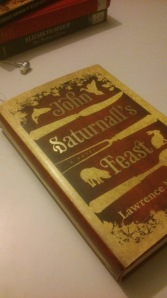

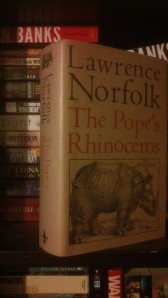


 Given these expectation on my side and many other readers of his work, when John Saturnall’s Feast came out, a medium-sized, easily read little book that had a small portion of myth, to go with a historical background and an engaging story, previous readers of Norfolk had to feel a bit let down. If you reread the effusive praise I have just offered for his other books, you could claim that I just had unreasonable expectations. That may be so. But I can’t help but feel that this step back is deliberate. In The Shape of a Boar was not as well received as his previous work and it had to have sold much fewer copies. In writing this short, very pretty book, he clearly appealed to the audience of his earlier books, and maybe, after the rumored failure of a much more ambitious project that was abandoned during the 12 years between novels three and four (one of the rumors was based on titbits like this note from a British Council webpage ca. 2006 that said “He is currently working on a new novel, The Levels, about the effect of gravity on human relationships.”), this smaller project helped him center, retool his writing. I don’t know and generally I don’t like this kind of speculation. So let’s move on to the book itself.
Given these expectation on my side and many other readers of his work, when John Saturnall’s Feast came out, a medium-sized, easily read little book that had a small portion of myth, to go with a historical background and an engaging story, previous readers of Norfolk had to feel a bit let down. If you reread the effusive praise I have just offered for his other books, you could claim that I just had unreasonable expectations. That may be so. But I can’t help but feel that this step back is deliberate. In The Shape of a Boar was not as well received as his previous work and it had to have sold much fewer copies. In writing this short, very pretty book, he clearly appealed to the audience of his earlier books, and maybe, after the rumored failure of a much more ambitious project that was abandoned during the 12 years between novels three and four (one of the rumors was based on titbits like this note from a British Council webpage ca. 2006 that said “He is currently working on a new novel, The Levels, about the effect of gravity on human relationships.”), this smaller project helped him center, retool his writing. I don’t know and generally I don’t like this kind of speculation. So let’s move on to the book itself.
